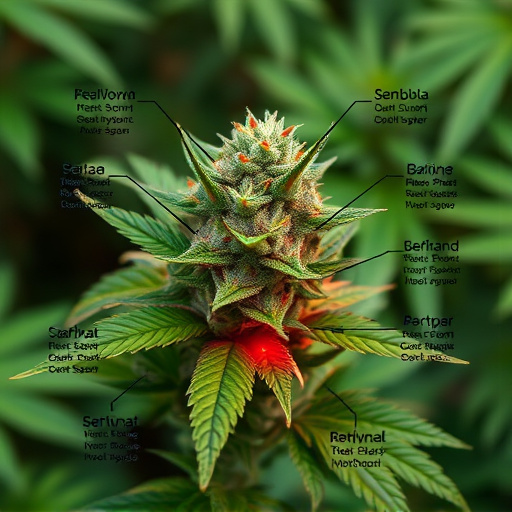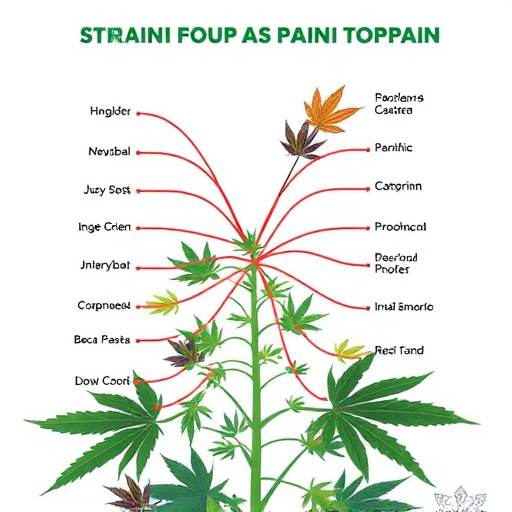Cannabis, with its diverse strains and interaction with the endocannabinoid system, offers medicinal benefits but requires responsible use. High-THC strains, popular for their potency, can induce anxiety or cognitive issues, especially in inexperienced users. For chronic pain relief, strains rich in CBD or balanced THC/CBD profiles are recommended, as they provide anti-inflammatory and analgesic properties with minimal psychoactive effects. Consulting healthcare professionals is crucial to select the most suitable strain for individual needs and conditions.
Can you overdose on cannabis flower? Despite its growing popularity, many question the safety of this potent plant. This article explores the intricacies of cannabis and its effects on the body, delving into the potential risks associated with high THC concentrations. We’ll navigate the various strains for pain management, emphasizing the crucial balance needed to achieve therapeutic benefits without adverse effects. Understanding these aspects is key to harnessing cannabis’s potential for pain relief in a responsible manner.
- Understanding Cannabis and Its Effects on the Body
- Potential Risks of High THC Concentrations
- Strains for Pain Management: Finding the Right Balance
Understanding Cannabis and Its Effects on the Body

Cannabis, or marijuana, is a complex plant that has been used for both medicinal and recreational purposes for centuries. Its effects on the body are multifaceted, influenced by factors such as strain composition, method of consumption, and individual tolerance. When consumed, cannabis interacts with the endocannabinoid system (ECS), a network of receptors found throughout the body that play a significant role in regulating various physiological processes including pain perception, mood, appetite, and memory.
Different strains of cannabis are bred for specific effects, with many marketed for their potential to alleviate symptoms of chronic pain. These strains vary in concentration of tetrahydrocannabinol (THC), the primary psychoactive compound responsible for feelings of euphoria and relaxation, as well as cannabidiol (CBD), which has gained attention for its possible anti-inflammatory and analgesic properties. While cannabis is generally considered safer than many prescription medications, an overdose—typically characterized by severe anxiety, paranoia, and disorientation—is still possible. This risk can be heightened with potent strains or when consumed by inexperienced users, underscoring the importance of responsible use and understanding one’s personal tolerance.
Potential Risks of High THC Concentrations

High concentrations of THC, the primary psychoactive compound in cannabis, can pose potential risks, especially for users who consume strains with elevated THC levels, often sought after for their potent effects. While cannabis is generally considered safe when used responsibly, the powerful potency of modern strains, some containing over 30% THC, can lead to an increased risk of adverse experiences.
Individuals using strains of cannabis for pain or other medical purposes should be aware that higher THC concentrations may intensify desired therapeutic effects but could also result in unpleasant side effects such as anxiety, paranoia, and cognitive impairment. The potential risks are particularly relevant when consuming edible cannabis products, as their effects can be more prolonged and intense compared to smokable forms. It’s crucial for users to start with low doses and gradually increase to find the right balance between therapeutic benefit and manageable side effects.
Strains for Pain Management: Finding the Right Balance

Cannabis flower has gained attention for its potential in managing various types of pain, with specific strains showing promise for treating chronic conditions like arthritis, fibromyalgia, and nerve pain. Different strains of cannabis offer unique chemical profiles, with key compounds such as THC (tetrahydrocannabinol) and CBD (cannabidiol) playing crucial roles in alleviating pain symptoms.
When seeking relief through cannabis, finding the right balance is essential. Strains high in CBD have been shown to interact differently with the body than those high in THC, often offering minimal psychoactive effects while providing strong anti-inflammatory and analgesic properties. This makes them suitable for individuals looking to manage pain without experiencing euphoria or cognitive impairment. The ideal strain selection depends on individual tolerance, desired effects, and specific pain conditions, highlighting the importance of consulting with a healthcare professional or experienced cannabis clinician.
While cannabis flower can offer significant relief for certain conditions, especially when it comes to managing pain through specific strains, it’s crucial to understand that an overdose is not typically a concern compared to other substances. The key lies in finding the right balance—using strains with controlled THC levels tailored to individual needs. By carefully selecting strains for pain management and consuming responsibly, individuals can harness cannabis’s therapeutic properties without undue risks.














